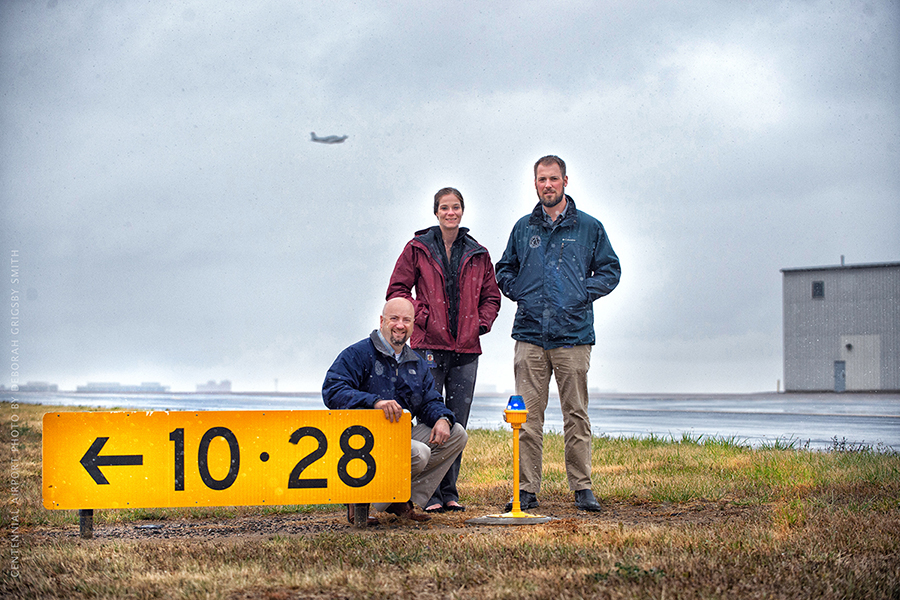State public health, environment office gives nod for lighting, other efforts
Led by Centennial Airport staff members, from left to right, Mike Fronapfel, director of planning; Gina Conley, senior planner; and Dylan Heberlein, noise and environmental specialist, the airport’s lighting energy-reduction effort earned it a Bronze Level Achievement recognition from the Colorado Department of Public Health and Environment’s Environmental Leadership Program. Centennial Airport was one of 16 bronze-level achievers honored at this year’s awards ceremony Oct. 9 in Glendale.
COURTESY OF DEBORAH GRIGSBY SMITH/CENTENNIAL AIRPORT
Staff report
Centennial Airport received an award from the Colorado Department of Public Health and Environment for reducing energy use on its airfield, along with several other environmental efforts, according to a news release by the airport.
The department and its Pollution Prevention Advisory Board honored the airport and 167 other entities across the state at its annual Environmental Leadership Awards ceremony — part of the Colorado Environmental Leadership Program — in Glendale at Infinity Park Event Center earlier this month, according to the release.
The 50-year-old airport has reduced the energy footprint on two of its three runways, associated connectors and taxiways by more than 46,000 kilowatt-hours.
Former Gov. Bill Ritter, now founding director of the Center for the New Energy Economy at Colorado State University, served as keynote speaker.
Ritter, who also spoke at the 2015 Paris Climate Conference, told the audience of 400 government, business and community leaders that the heavy lifting on environmental issues doesn’t always come from policymakers at the top, but rather “The real work is being done at the state and local level, and by the private sector,” according to the release.
The airport was among 16 bronze-level winners statewide.
“We are very excited to be among those to be named a Bronze Level Achiever this year,” said Dylan Heberlein, noise and environmental specialist for the airport, in the release. “While this is our first year to be recognized, it’s nice to know that what we’ve been doing here at the airport over the past five years has been on track.”
The state’s program, now in its 19th year, recognizes environmental achievements that help keep the state a desirable place to live and work.
“For us, we saw the biggest return when we replaced conventional incandescent edge lighting, along airport-movement areas, with low-energy light-emitting diode (LED) lights,” Heberlein said in the release. “Along with upgrades to airfield wiring and new, more efficient voltage regulators, we’ve seen a significant reduction in overall kWh usage over the past five years.”
In total, the airport replaced more than 1,000 runway and taxiway lights over the past five years, as well as lighting in 80 on-airfield directional signs.
“We’re making a lot of small changes that, for us, have delivered some really impressive results,” said Gina Conley, senior planner for the airport, in the release.
The airport’s energy bills from 2015 to 2017 show a reduction of 46,440 kWh, or about $6,600 in savings. According to statistics from the U.S. Energy Information Administration, that savings could power four residential homes for just over a year.
“LED lighting lasts longer than conventional lighting, so there’s some noticeable savings when it comes to replacement parts,” Conley said in the release. “In addition, the LEDs are brighter, crisper, more visible, and that’s a big win when it comes to runway safety.”
Those numbers only reflect the energy savings for two of the three runways, Heberlein said.
“We will be replacing the lighting on our parallel runway (RWY 17R/35L) and its associated taxiway in the summer of 2020, so we expect to see even more reduction in energy use in the very near future,” Heberlein said in the release.
Along with its lighting-upgrade project, the airport also was applauded for its stormwater-spill prevention and control countermeasure, its wildlife-mitigation program, overall environmental best practices and strong partnership with the Centennial Airport Community Noise Roundtable.
Formed in 2008, the roundtable is composed of elected and appointed officials from local municipalities and counties. The airport meets with them monthly to discuss the effects of aircraft noise on surrounding communities.
CDPHE’s environmental recognition program offers benefits and incentives to members who voluntarily go beyond compliance with state and federal regulations and commit to continual environmental improvement. It is open to all Colorado businesses, industries, offices, educational institutions, municipalities, government agencies, communities, nonprofits and other organizations.
“We know that striving for environmental sustainability is the right thing to do,” said Mike Fronapfel, director of planning and development for the airport, in the release. “And as we go forward, we’ll continue to seek out more ways to collaborate with stakeholders to identify and reduce environmental impact.”

